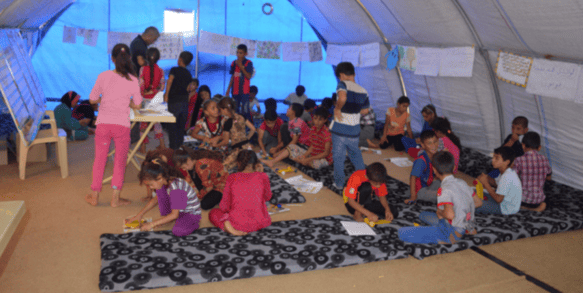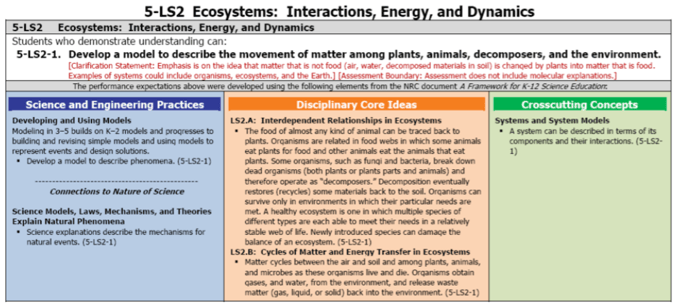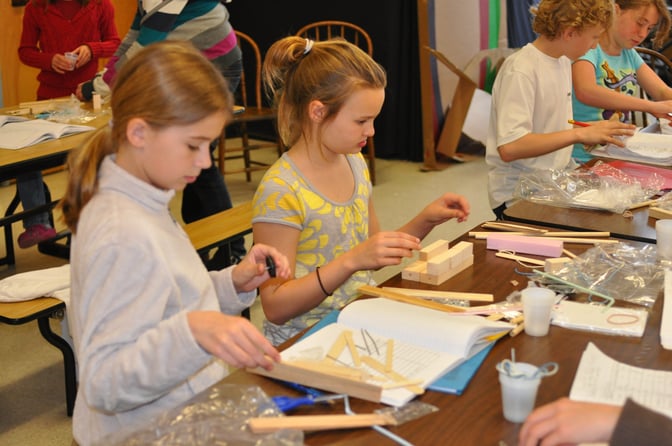As districts begin to implement the Next Generation Science Standards, there is growing awareness that classrooms need to create inquiry environments where students engage as scientists and engineers.

Inquiry environments allow students to engage in the same behaviors that scientists use to answer questions and engineers use to solve problems.
However, many people make the mistake of assuming that standards and curriculum are the same thing. They aren’t, and to successfully implement NGSS—and create that inquiry environment—it is important to understand the difference. NGSS tell us the minimum expectations of what students will be able to demonstrate as a result of classroom instruction, but they do not tell us how students are to learn it. That is the job of curriculum.

The standard is stated in white, and the three dimensions – practices, disciplinary core ideas, and crosscutting concepts – are listed below it in the colored boxes.
Let’s begin with standards themselves. Take the image above, which shows one fifth grade Life Science standard. The standard itself is a performance expectation, which is found in the white box: Develop a model to describe the movement of matter among plants, animals, decomposers, and the environment.
Because it is a performance expectation, student mastery happens when students are able to develop a model that shows how matter moves between the living and nonliving parts of an ecosystem. Before we can expect students to carry out this performance expectation successfully, however, we have to offer context through the three dimensions:
- Science and engineering practices: These are the eight practices identified by the National Research Council as the behaviors that scientists use to answer questions and engineers use to solve problems in the real world.
- Disciplinary core ideas: These form the basis of what most educators would consider STEM "content knowledge," also known as scientific facts. Rather than being a series of isolated facts, they are dynamic and interrelated in numerous ways.
- Crosscutting concepts: These are concepts that apply across all scientific disciplines and provide students with an organizational framework to connect ideas from different scientific disciplines. They help students form a larger and more comprehensive picture of the world.
None of these dimensions is the standard itself, but when students use the three dimensions together, they will be able to master the performance expectation.
Going back to that fifth grade Life Science standard, the scientific facts needed to understand this performance expectation are in the orange Disciplinary Core Ideas box. Remember that these are not isolated facts, but rather content that is connected to other content from other lessons. This content describes the interdependent relationships within an ecosystem, and how matter and energy is transferred between the living and nonliving parts of an ecosystem.
However, students shouldn’t just memorize these scientific facts. Instead, they will need to use the science and engineering practices—listed in the blue box on the left—to explore and engage with the content. They will need to be able to develop a model—not just identify the parts of a model that is given to them.
The Role of Curriculum
The curriculum creates the classroom environment because it gives students contexts to develop their skills and to interact with the content and concepts.
The context is determined by you, the teacher, but students should be able to use their skills and apply their knowledge equally well whether that context is a marine ecosystem or Arctic tundra. They should be able to see the similarities and differences between these two contexts, and when they can, that is true mastery.
Practice skills make content accessible in many contexts.
When students access content through practice skills, they have the flexibility to engage with this content in many different contexts. They

Here we see students engaging with disciplinary core ideas and accessing STEM content via practices.
Note that the context is determined by you, the teacher, but that students should be able to use their skills and apply their knowledge within it equally well whether that context is a marine ecosystem or an arctic tundra. They should be able to see the similarities and differences between these two contexts, and when they can, that is true mastery.
A Framework of Standards
The result of this approach is that the standards inform curriculum over and over again. The standards should be used in a variety of ways to inform content, to enlighten students about disciplinary core ideas, to help them identify crosscutting concepts, and to learn to become scientists and engineers.
We have to be careful to avoid the following: teach one standard, move on, and don’t return.
The Next Generation Science Standards are intended to work as a system. The practices and concepts interact, and their value builds successively over time. Because of this systematic approach, students should be able to enter and exit the district and still engage meaningfully with the content because it is contextualized well. If a standard is only taught for a brief amount of time, this becomes less possible.
Unfortunately, the lowest performing districts tend to cling to the old model, isolating concepts and trying to explain them one at a time. For three months, say, they might focus on rocks and minerals. Everything during those three months is about this one topic, and then the class moves on, not experiencing that content again until future grades. This isolation of concepts works against students’ ability to generate a meaningful framework for their understanding of science.
You don’t just use practice skills once; you use them all the time. You don’t use a knowledge base and then leave it behind; you incorporate it into your new worldview.
The idea that concepts can be taught once and left alone is counter to what we know about how people learn. This is why we use standards to help students engage with knowledge and practices in new contexts, deepening their skills over time.
This post was updated on 8/24/17.



